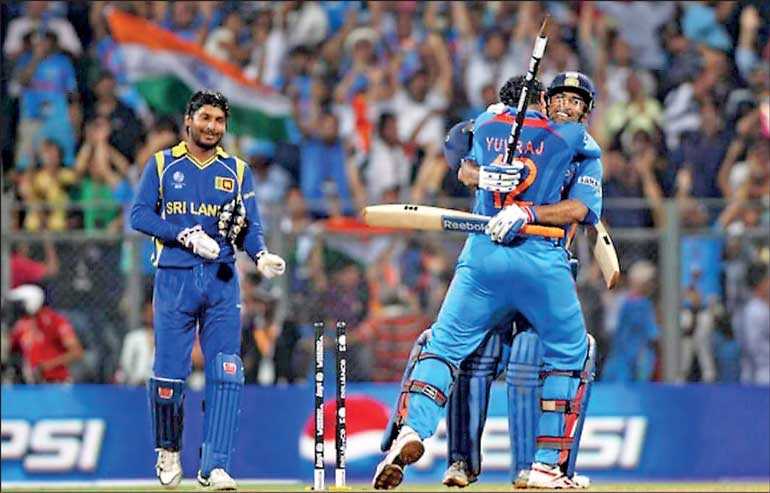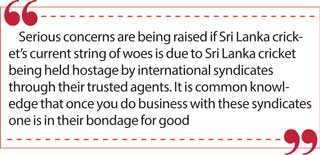Tuesday Apr 08, 2025
Tuesday Apr 08, 2025
Wednesday, 24 March 2021 00:05 - - {{hitsCtrl.values.hits}}

India celebrates their win in the 2011 Cricket World Cup final against Sri Lanka at Mumbai
By Sa’adi Thawfeeq
The information filtering through the grapevine on the backroom manoeuvres underway to hijack the mandate of the National Selection Committee by the Cricket Technical Advisory Committee is extremely worrisome.
Serious concerns are being raised if Sri Lanka cricket’s current string of woes is due to Sri Lanka cricket being held hostage by international syndicates through their trusted agents. It is common knowledge that once you do business with these syndicates one is in their bondage for good.
A case in point is that champion cricketer of South Africa Hansie Cronje who reached a point where he could no longer carry the burden of guilt on his mind and decided to spill his wrongdoings and beg forgiveness from his fans and countrymen. This confession led to an extensive investigation by the Indian Central Bureau of Investigations (CBI – Equivalent to the FBI of the USA). 
This investigation report shook the very foundations of cricket worldwide, leading to several countries slapping lifetime bans on several superstar cricketers including the likes of Mohammad Azharuddin, Manoj Prabhakar of India, and Salim Malik of Pakistan among a host of other cricketers. The notices were sent to BCCSL back then with details of the Sri Lankan players whose names were revealed during the investigations.
The CBI report can be accessed on the internet @
The evidence stated in the report was largely based on confessions, and in inimitable Sri Lankan fashion the notices were swept under the carpet by the agents of this sinister industry who were in charge of Sri Lanka Cricket (SLC) at the time.
The players implicated were subsequently conveniently exonerated citing lack of evidence by a one-man commission in a country where justice is often confined to the crime of picking a fallen coconut to overcome hunger pangs, but large-scale white collar plunder is often rewarded and even applauded.
The repercussions of such inaction have come to haunt Sri Lanka cricket where the accused cloaked in cricketing laurels position themselves to carry on regardless even after fingers are pointed at them by none other than a former Minister of Sports, and a senior Cabinet Minister of the Government.
When one carefully examines the subversion, the sophistication of the plan is clear to see. The appointment of the Cricket Technical Advisory Committee and its composition appears to have been recommended to the Sports Minister of Sports by the National Sports Council.
Sports Minister ill-advised?
In the face of the mismanagement that is being revealed at the Parliamentary COPE hearing, the need of the hour was the appointment of an Interim Committee or a Competent Authority. However, by improperly advising the Sports Minister to appoint a Technical Committee, the status quo remains unchanged, and leads to more chaos and confusion in the administration of cricket. What is more alarming to note is news of the Technical Committee spending all their energy on appointing selectors.
The fact that the current President of the MCC, which is the custodian of the game and considered a gentlemen’s club, is sitting in these sub-committees whilst all these shenanigans are being enacted is more damning to say the least. The founders of that august establishment would naturally be appalled at the damage being done to their beloved game of cricket in Sri Lanka.
They should instead be focusing on guiding the Sports Minister on restructuring the cricket administration for accountability and efficiency. Restructuring the tournament formats to improve the standard of the game. Review and fix weaknesses in the coaching and support staff among others (especially in the light of the appalling quality of technique/s on display).
In spite of these burning issues, all they have managed to do thus far is to drain the coffers of SLC for a colossal sum of $ 600,000 with no idea or a roadmap on how a foreign expert can come and fix persistent systemic flaws without local knowledge.
In fact it should have been them getting their hands dirty and fixing the problems. But, it appears they have more important tasks to undertake fixing Indian cricket and therefore choose to conveniently hand over the matters to a foreigner and take wing in search of more lucrative pursuits – of course not before exerting pressure and prevailing on the Minister of Sports to appoint their chosen candidates to the National Selection Committee where everything runs smoothly on remote control at their behest.
A similar scenario is unfolding in Pakistan where an ex-Captain who was also accused of fixing a World Cup final has once again being cited for interference with selections with no official status, giving credibility to the belief that there is a major international syndicate which has wrested control of selections in several countries by strategically placing its trusted operatives in key places.
ICC living in a fool’s paradise
Sadly, even the ICC has been living in a fool’s paradise when it comes to stamping out corruption from cricket. Little or nothing has been done to protect the independence and integrity of team selections with clearly-defined rules and regulations in place.
If the ICC thinks that they can keep match fixers at bay with a group of retired policemen, they cannot be more wrong. What is required is a strong set of rules to foster independence and integrity of team selections, as this is the gateway to corruption as evidenced in Sri Lanka over the last five years from promissory selections to what not, earning us accolades as the “most corrupt country” in the international circuit.
The reason why cricket experts are needed in the Anti-Corruption Unit is to keep an eye on unusual team selections/changes at crucial games and unusual phases of play where strike bowlers are kept away from the attack for extended periods of time, etc. If the ICC had such a team of cricket experts, some of the questions that would have been posed (but not even asked in passing after 10 years) on the 2011 World Cup final should have been answered.
Take for example the following:
Why was the best bowler in your team (in fact the best in the tournament) leading up to the final dropped without a plausible explanation for the final?
What was the “strategy” behind a second off-spinner being flown in direct to the final, with the best bowler in the team, and a left-arm leg-spinner from the original squad sitting in the dressing room?
Particularly when your opposition had 9, repeat 9, right-hand batsmen?
Why wasn’t the best off-spinner in the team not brought into bowl until the 22nd over and dew had started to fall?
Why was the main strike bowler having struck two early blows not re-introduced to the attack until the 35th over in spite of a flourishing Gambhir-Dhoni partnership?
The doubts that persist in the minds of a majority of cricket fans to date over that final seem naturally justifiable in the face of the above unfathomable reasons.
Discover Kapruka, the leading online shopping platform in Sri Lanka, where you can conveniently send Gifts and Flowers to your loved ones for any event including Valentine ’s Day. Explore a wide range of popular Shopping Categories on Kapruka, including Toys, Groceries, Electronics, Birthday Cakes, Fruits, Chocolates, Flower Bouquets, Clothing, Watches, Lingerie, Gift Sets and Jewellery. Also if you’re interested in selling with Kapruka, Partner Central by Kapruka is the best solution to start with. Moreover, through Kapruka Global Shop, you can also enjoy the convenience of purchasing products from renowned platforms like Amazon and eBay and have them delivered to Sri Lanka.
Discover Kapruka, the leading online shopping platform in Sri Lanka, where you can conveniently send Gifts and Flowers to your loved ones for any event including Valentine ’s Day. Explore a wide range of popular Shopping Categories on Kapruka, including Toys, Groceries, Electronics, Birthday Cakes, Fruits, Chocolates, Flower Bouquets, Clothing, Watches, Lingerie, Gift Sets and Jewellery. Also if you’re interested in selling with Kapruka, Partner Central by Kapruka is the best solution to start with. Moreover, through Kapruka Global Shop, you can also enjoy the convenience of purchasing products from renowned platforms like Amazon and eBay and have them delivered to Sri Lanka.